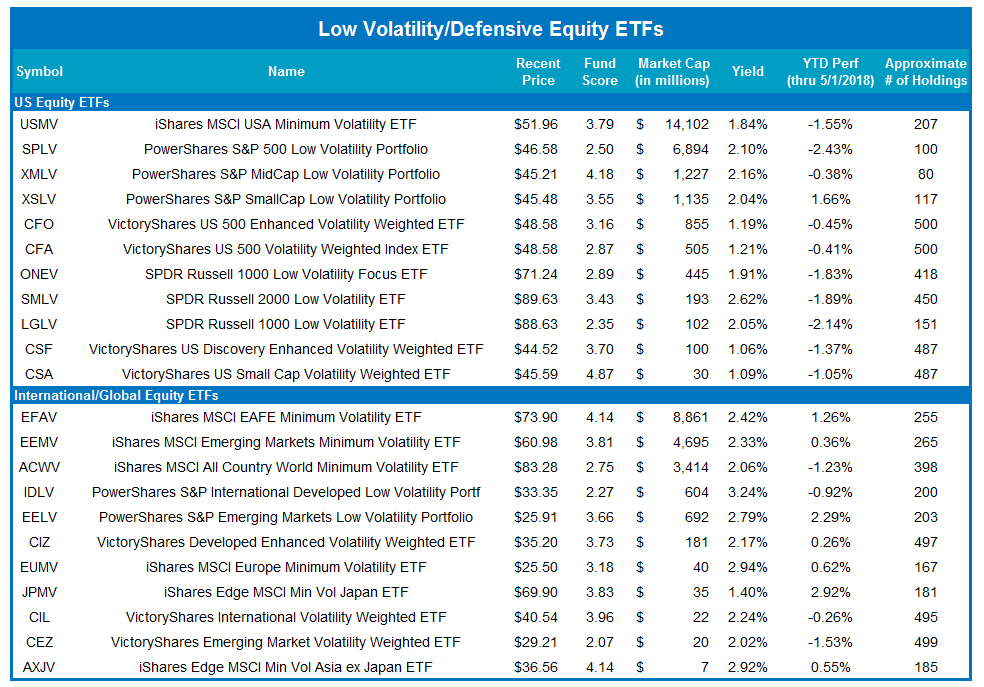
In light of the move into the seasonally weak period for the market, today we look at major market ETFs that offer a slant towards low or minimum volatility.
Portfolio View - Major Market ETFs
| Symbol | Name | Price | Yield | Trend | RS Signal | RS Col. | Score | 200 Day MA | Weekly Mom |
| DIA | SPDR Dow Jones Industrial Average ETF Trust | 240.76 | 2.04 | Positive | X | 3.36 | 237.21 | +2W | |
| EFA | iShares MSCI EAFE ETF | 70.49 | 2.56 | Positive | Sell | O | 2.69 | 69.52 | +4W |
| FRN | PowerShares Frontier Markets ETF | 15.57 | 3.46 | Positive | Sell | X | 4.12 | 15.17 | -6W |
| IJH | iShares S&P MidCap 400 Index Fund | 187.68 | 1.29 | Positive | Buy | X | 3.94 | 184.29 | +2W |
| IJR | iShares S&P SmallCap 600 Index Fund | 78.16 | 1.20 | Positive | Buy | X | 5.37 | 75.01 | +2W |
| QQQ | PowerShares QQQ Trust | 162.78 | 0.80 | Positive | Buy | X | 5.33 | 155.06 | +1W |
| RSP | PowerShares S&P 500 Equal Weight ETF | 99.89 | 1.62 | Positive | Buy | X | 4.61 | 98.41 | +2W |
| SPY | SPDR S&P 500 ETF Trust | 264.98 | 1.84 | Positive | O | 2.51 | 261.02 | +2W | |
| VWO | Vanguard FTSE Emerging Markets ETF | 45.42 | 2.37 | Positive | Sell | O | 4.39 | 45.57 | -7W |
| XLG | PowerShares S&P 500 Top 50 ETF | 188.02 | 1.86 | Positive | O | 2.33 | 185.69 | +2W |
Additional Comments:
As we enter the month of May, we also move in to what is generally regarded as the "seasonally weak" six month period in the market (from May through October). We have discussed this concept of seasonality in a few of the recent market comments, mainly with respect to some of the model portfolios we track that shift allocation twice a year based on the seasonal periods. These models are designed to balance momentum strategies with low volatility strategies, putting an emphasis on the high momentum portion from November through April and then overweighting low volatility from May through October. With more and more ETFs now available to investors, we wanted to compile a list of the various low volatility or defensive equity ETFs. In the table below there are a total of fourteen ETFs that are categorized in this niche of the market: eight are focused in US equity market segments and the remaining six are global or international equity products. Each product tracks an index that uses various metrics to determine which individual stocks can be considered for inclusion; and as a result, you'll see different returns, yield, fund scores, etc., for each. If you want to read more about the strategies that drive these ETFs, you can visit the respective provider's page for an overview of each.

When looking at the list above, we find that the iShares MSCI USA Minimum Volatility ETF USMV is the largest out of the 11 US equity ETFs with a market cap in excess of $14 million. As its name suggests, the USMV tracks the MSCI USA Minimum Volatility Index, which is designed to reflect, “the performance characteristics of a minimum variance strategy applied to the large and mid cap USA equity universe. The index is calculated by optimizing the MSCI USA Index, its parent index, in USD for the lowest absolute risk (within a given set of constraints). Historically, the index has shown lower beta and volatility characteristics relative to the MSCI USA Index.” (Source: www.ishares.com). Looking to the trend chart below, the ETF shows a long term bullish pattern, as it has given five consecutive buy signals since September 2015, with the last occurring at $51 in October of last year. After reaching a new all-time high at $55 in January, USMV pulled back along with the broader market in February. It has since reversed back up into X's at $53 and is just three boxes away from breaking a double top, as well as reaching a new all-time high. With a fund score of 3.79 coupled with an OBOS% of -10%, the weight of the evidence is positive for USMV, making it a viable option for new positions, especially for those interested in increasing their low vol exposure as we enter the seasonally weak period.

